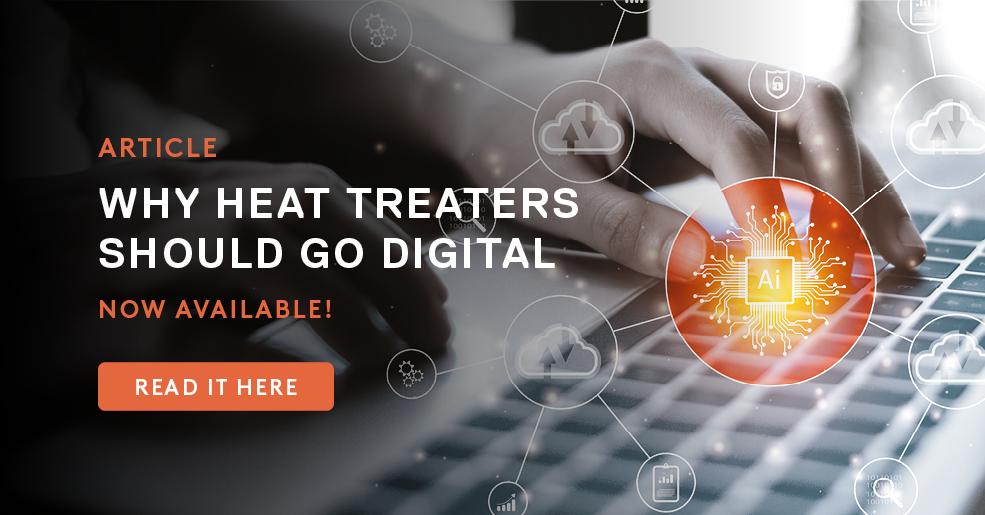The Benefits Of Digitalization In The Surface Treament Industry
Even if more and more heat treating companies are digitalizing their operations, the industry still seems to be lagging compared to other sectors.
But the shift towards Industry 4.0 is inevitable as the world gets increasingly connected and knowledge needs to be preserved. And there are certainly plenty of advantages for heat treaters to go digital!
Increasing Profitability
Competency and efficiency drive success in heat treating. Can you meet or exceed the required quality and performance criteria repeatedly and reliably, and deliver a good level of service to your customer? Competency is not only driven by knowledge, experience and well-established business practices, but by the use of top quality equipment and controls.
Digitalization will transform the industry and provide a big advantage for those who embrace it. It will:
– maximize furnace loads;
– increase first-pass quality;
– decrease unplanned downtime;
– control energy intensity and gas-related input to create less waste;
– prevent undesirable situations (like breakage and failures);
– make it easier to share information across organizations and with customers;
– improve the ability of employees to learn and draw conclusion from data.
“By learning to take advantage of the tools provided by digitalization, [fewer] employees will be able to have a more significant outsized positive effect on our operations,” says Jason Orosz, president of Heat Treat Services at Nitrex.
Centralizing Knowledge
Knowledge is eroding in the industry. With a lot of small and medium players, it gets fragmented, more difficult to transfer and, except for some countries like Poland and Germany, heat treating isn’t taught in schools anymore.
“Young people are not too interested in working in an old-fashioned heat treating environment. So, recruiting and retaining employees will become even more complicated and difficult,” explains Iwo Korwin, president of Nitrex Turnkey Systems.
That’s why companies need solutions to centralize knowledge. With a cloud-based platform, they can find all the information they need on their assets. Furnaces become easier to operate, with more data, more automation, more protective maintenance, and the use of machine learning to predict and prevent potential failures.
Having smart furnaces that utilize artificial intelligence or machine learning means more collected data but also better use of it. “Processing all of this data will pinpoint the weakest links, therefore allowing designers to improve products in a more efficient way,” states Iwo Korwin.
Smarter furnaces raise the efficiency, safety and quality of the whole process, without having to overly rely on a few skilled individuals. And this is more important as heat treaters could deal with increasingly complex parts in the future.
Connectivity
Industry 4.0 is also a must as the world gets even more connected. Customers want to have access to information anytime, anywhere. With a digitalized system, data like gas mixtures and pressure can be more easily gathered, categorized, cleaned by relevance and analyzed.
Of course, many heat treaters will be challenged by this technology. “They will be forced to invest, train their staff, and adapt their business model and their processes to follow the digital evolution,” assesses Olivier Caurette, president of UPC-Marathon at Nitrex.
But eventually, companies will reap the rewards. Data collection and analysis will be fully automated to achieve predictive quality and benefit their bottom line.
Going Green
Reducing your energy carbon footprint also makes good business sense as energy is one of the largest expenses of heat treatment companies. For this reason, energy-efficient technologies are even more profitable. Nitrex has even developed a digital platform solution for that purpose.
At its core, energy efficiency and carbon footprint reduction is about collecting and using data in a relevant manner. “Historically, doing these calculations and consolidating data into something meaningful [was] a huge undertaking [but] now we have a platform-type tool that easily collects, tracks, trends and consolidates this data,” Jason Orosz explains.
One example is that, in order to meet the Paris agreement, the need to track CO2 consumption in the heat treatment process will increase. That’s why making sure products can lower those types of emissions is key, illustrates Nitrex CEO Jean-François Cloutier.
Moreover, by ensuring predictive quality and preventing failures and breakage through predictive maintenance, digital solutions limit waste and extend the life of machines for a more ecofriendly outcome.
But even if improvements have been made over the years, like with burner designs and insulation, there is more work to be done when it comes to measurement, power management, and equipment efficiency. There’s still a huge amount of waste in average heat treating operations, like flue gases, water chillers, and oil coolers, so engineers and innovators in the industry need to find a way to potentially reuse these sources of energy.
Data Protection
Data privacy challenges and data protection have already been addressed by nearly all other sectors of activity, whether it’s about cloud-based security, encryption, etc.
“It’s definitely a concern going forward as more and more data is generated from our business practices, what do we do with it, where it goes, where it’s stored, who has access to it…” weighs in Jason Orosz.
Digitalization and cloud security is inevitably starting to infiltrate the heat treating industry though, he argues, as it has done for other sectors like government services and online banking. Therefore, everyone will need to accept that these changes are coming.
************************
This content was taken from an executive roundtable held in January 2022, called Executive Roundtable: How Emerging Technologies will Shape the Future of Surface Treatment. During this webinar, Nitrex CEO Jean-François Cloutier, and the presidents of the Nitrex’s three business units, Jason Orosz (Heat Treat Services), Olivier Caurette (UPC-Marathon), and Iwo Korwin (Nitrex Turnkey Systems), all shared their thoughts about the topic.


